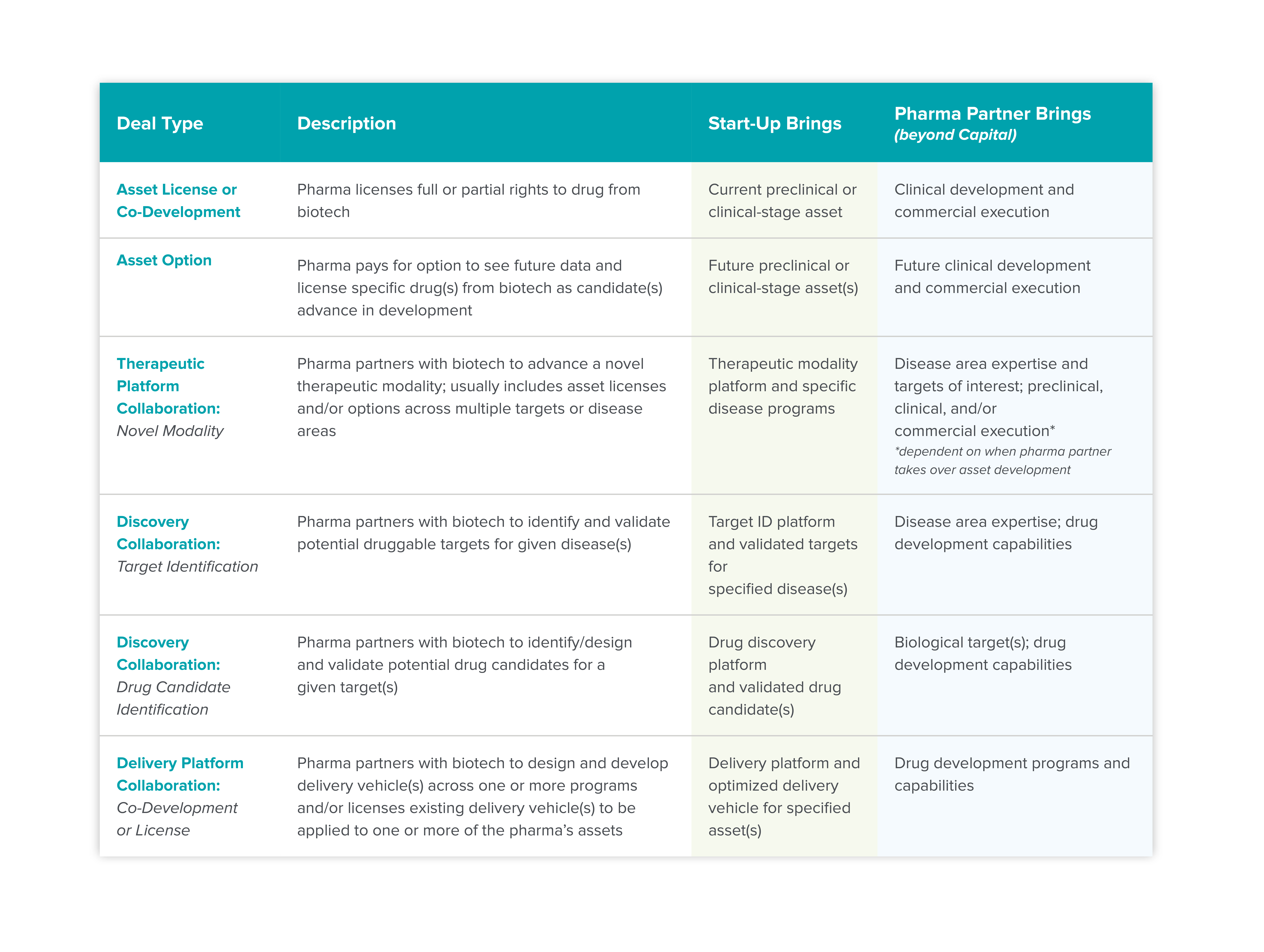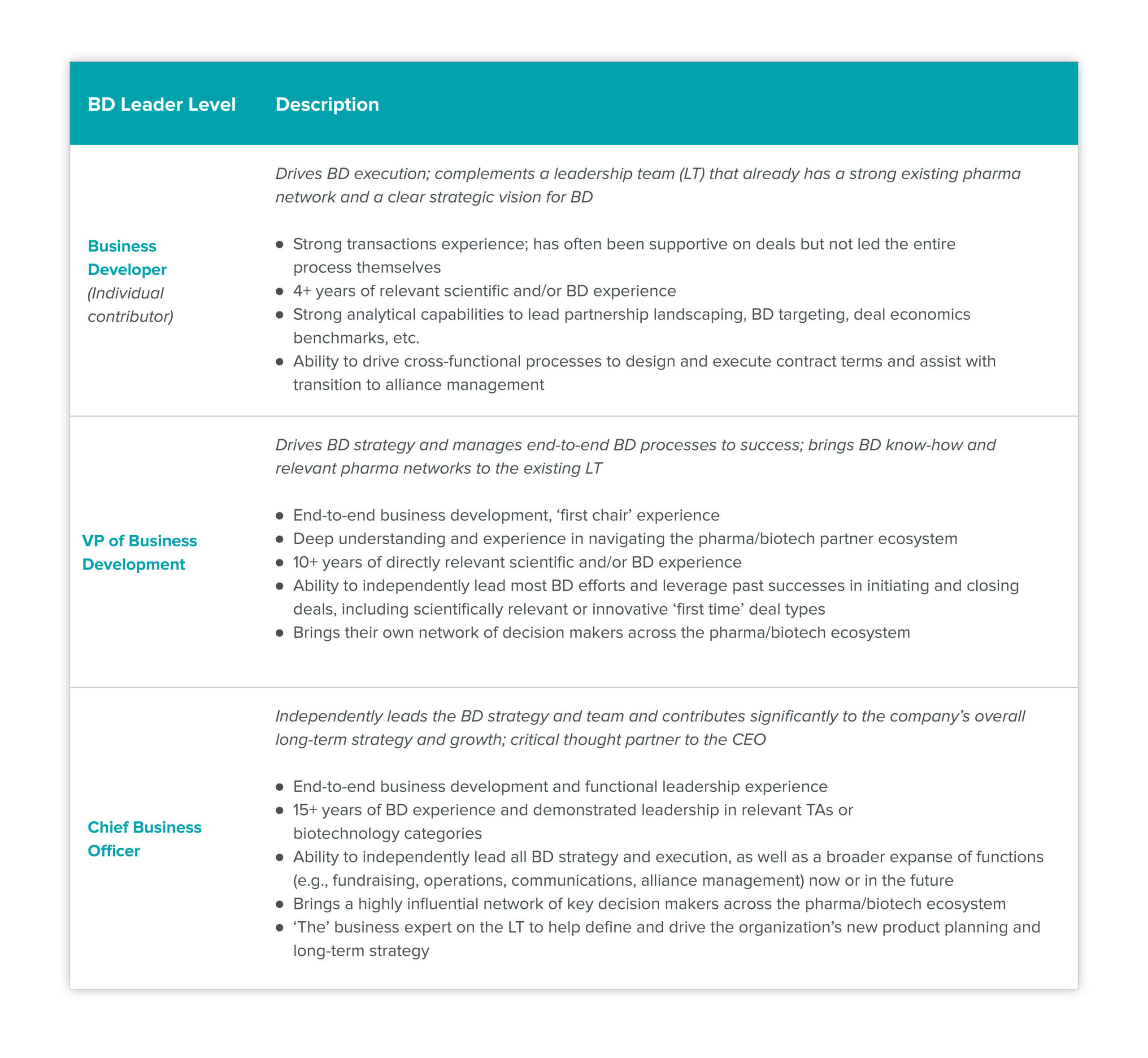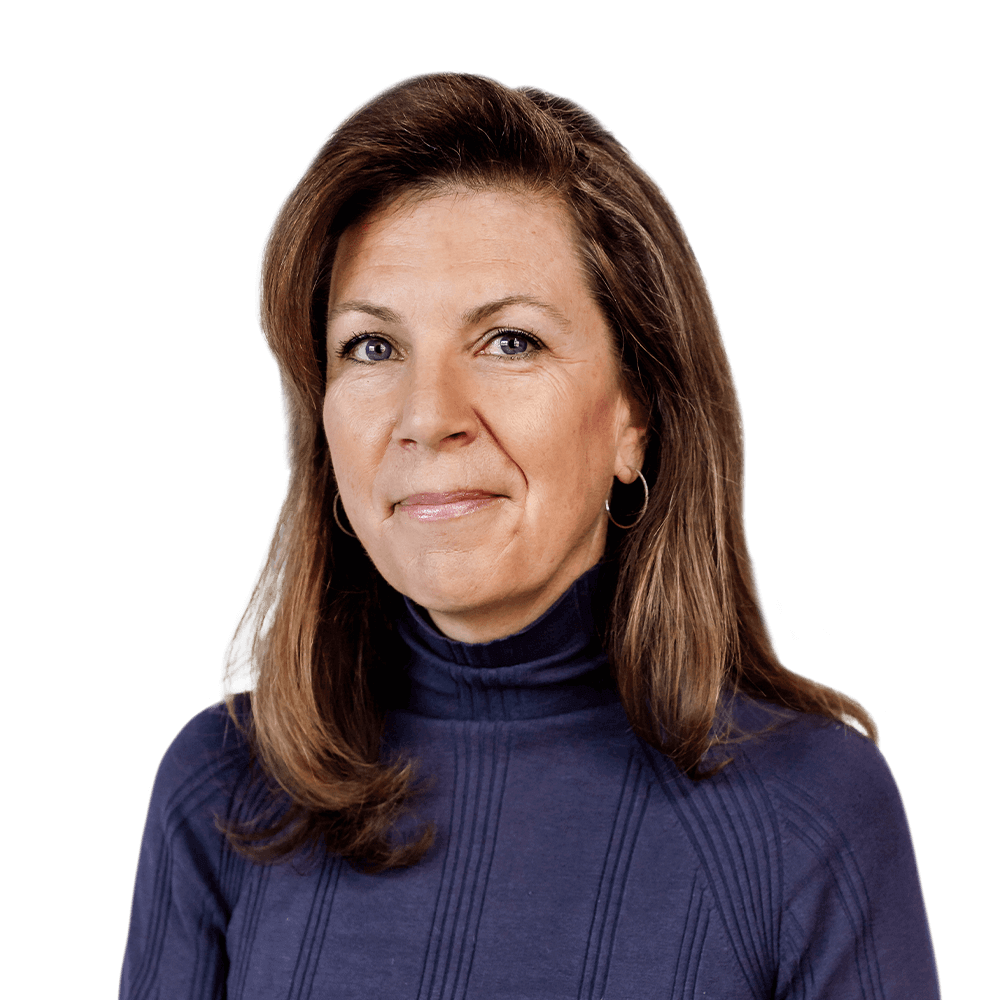Now more than ever, business development is top of mind for biotech founders. Scientific collaborations have always been an essential piece of the drug development ecosystem, enabling small biotech companies to accelerate and maximize the impact of their therapeutic platforms. In recent months, changing market dynamics are propelling even more partnership activity forward. With downstream investors’ standards for proof-of-concept rising, biotech companies race to extend their cash runways via non-dilutive capital and validate their platforms with pharma partner support.
A successful business development (BD) initiative requires leadership. Someone from your team must (1) develop the BD strategy and targets, (2) design and negotiate collaboration terms, and (3) manage partnerships to success. In many cases, particularly for the first deal or two, this role might be filled by a founder/CEO committed to understanding and driving the behind-the-scenes policies, processes, and moving parts. But at what point should the founder hire a dedicated BD leader? And how do you find the right one?
Our time working at and with fast-growing, venture-backed biotech companies has given us a unique set of experiences in supporting founders as they make their first BD hire. In this guide, we offer advice on how to integrate industry-specific considerations into the candidate profile and search strategy, how to effectively evaluate candidates, and ultimately how to get the right biotech BD leader onboard at the right time.
TABLE OF CONTENTS
Timing is everything
TABLE OF CONTENTS
Just as a tech founder must recognize the right moment to hire her first head of sales, a biotech founder must do the same for BD. Bringing on a dedicated leader too soon may mean twiddling thumbs or a mismatch with the company’s longer-term needs, particularly for a nascent platform that continues to drastically evolve. But hiring too late means an overworked team reacting vs. driving a true strategy, or scrambling to close a potentially suboptimal deal.
Ask yourself a few simple questions:
- Are you working toward a new BD deal, or multiple deals, in the next 18 months?
- Will you or can you have the resources you need to support the desired collaboration(s) post-close?
- Is your current leadership team lacking the specific biotech BD experience and networks needed to achieve your BD goals?
If the answers to these questions are yes, now may be the right moment.
What’s the MOC?
The Mission-Outcomes-Competencies framework can help you build a comprehensive candidate profile for any new hire. It consists of three parts to help guide your thinking:
- Mission: The essence of the job and the overall goal in 2-3 sentences, using simple language.
- Outcomes: 5-8 specific objectives that support the mission, ranked by order of importance. What will this new hire be responsible for delivering?
- Competencies: The specific set of skills, experiences, and networks your candidate will need to achieve your desired outcomes. Here, it’s important to distinguish between “need to haves” and “nice to haves.”
When developing a job description for your first BD hire, it’s tempting to start by putting together a long list of professional experiences and qualifications you’re looking for in a candidate. We all want someone who has seen it all and checks all the boxes. However, we’ve found the MOC framework naturally guides you through a complete thought process starting with the company’s mission-critical goals and then working backwards to fill in the specific competencies that will enable a BD leader to achieve those goals.
As you start thinking through the Mission and Outcomes for this BD leader, zoom out to look at the 2-3 year time horizon in front of your company. What will be the overarching goal for this person in this time frame? What are the concrete accomplishments or objectives that will contribute to this overarching goal? What do you need her to achieve? At first glance, many biotechnology companies want the same thing: economically beneficial partnerships with pharma partners that will accelerate their platform validation. However, each biotech company has unique technology, therapeutic applications, business models, and leadership teams to take into account.
When you move to the Competencies section, consistently refer back to the mission and outcomes you’ve identified. This helps you narrow in on the specific experiences and skills that will give candidates a tangible advantage in accomplishing your company’s objectives. What are the technical, experiential, and leadership capabilities that are mandatory for this person? What are the ones that might be additive, but could be supplemented via advisors or other leadership team members?
Some key considerations to keep in mind while building your MOC:
- Responsibility Mixture: How many deals do you expect this leader to execute on in the next 2-3 years? One? Four? Fifteen? If just a few deals, what other company goals should this person ideally contribute to? These could include functions like alliance management, operations, fundraising, communications, new product planning, and/or long-term strategy development.
- Deal Types: What are the types of biotech deals on the table for your organization? How vital is it for your BD hire to have previous experience driving each of the specific deal types you’re targeting? We’ve outlined some common examples below, but there are of course many ways to slice the universe. Identifying the type(s) of deals your company is likely to do will help to define an ideal BD hire.
- Scientific Background: How important is it for this hire to have biotech experience within the therapeutic area (TA) or technology space at hand? Could the scientific and technology fundamentals be learned on the job and married with the candidate’s BD competencies? Or does the complexity of the domain warrant some baseline prior knowledge related to your technology platform and its applications?
- Seniority: A discussion around how the new BD hire might complement the activities and skills of the current leadership team is critical. For example, are you looking for a new hire who will work closely with the founder/CEO who was previously leading BD efforts? Or will this be a full handoff? What cross-functional capabilities or management of external relationships (e.g., with legal firms or consultants) are there to consider? Finally, is your team aligning the key needs of the position with known levels and associated titles in the biotech industry today? Consider the breakdown of BD leader levels below to help determine the appropriate seniority for your company’s needs.
Ultimately, developing the MOC as a team will drive alignment amongst your leadership by gathering and integrating the many different perspectives that undoubtedly exist. Alignment does not need to be universal, but the process will help you to identify where there are differences of opinion, address them, and prioritize accordingly. This will also drive consistency as you move on to build your search strategy, interview and evaluation processes. Based on feedback we’ve received, candidates take notice of these types of tight definitions and methods, and it makes a big (positive) difference.
Building your search strategy
Now that you’ve built your MOC, where do you start looking for candidates? In building your search strategy, it’s important to consider the whole bio ecosystem. What is the full range of company sizes and business types that may have relevant BD talent for your organization? Should you limit yourself to BD leaders from therapeutics companies? Or are there parallels with adjacent segments like diagnostics, contract research organizations, life sciences tooling and health technology? What about outside of healthcare altogether?
Again, mapping candidate pools back to the tangible competencies you need is a good way to pressure test your instincts through this process. Try not to rule out certain groups just because they haven’t worked at a company like yours or don’t look like you imagined. For instance, in considering candidates from the biotech “sell-side” and the pharma “buy-side,” what are the concrete activities and skills that each of those experiences instills? There is often more overlap than you might assume. A few examples:
- A BD leader at a small biotech vs. a large pharma may have both learned about the complexities of navigating a large organization to get a deal across the table, but from very different vantage points.
- A BD leader at a small biotech may have built her own “soup to nuts” process from the ground up. A BD leader at a large pharma may have learned from “assembly line” specialists who owned each stage of the BD process and developed a set of best practices.
- A BD leader at a small biotech vs. a large pharma have both learned to find creative applications and develop collaboration structures for a novel platform technology, but one was selling externally and another internally.
For each of the candidate pools you’re considering, how can you parse out the value of candidates’ learned insights, skills, and networks that connect back to your MOC? This thought process naturally leads us into the candidate interview and evaluation phase.
Candidate evaluation
As you embark on the candidate evaluation process, you can lean heavily on the work you did for the MOC by mapping interview questions back to each of the outcomes and competencies you defined. At this point you might also consider engaging a broader network of subject matter experts. These conversations can help you establish benchmarks for a variety of attributes you’re evaluating like executive presence, understanding of different deal types, cross-functional operations, and team/function building. How do other biotech founders and BD functional experts define excellence for each of the competencies you care about?
Once you start meeting with candidates, you’ll find yourself comparing and contrasting their deal sheets. But what’s on paper only tells you so much. During the interview process, try to ask questions to understand the candidate’s actual role and learnings from each deal. Consider the following categories and questions:
- Deal Process & Mechanics
- How does the candidate describe her personal role for each deal on her deal sheet? Are her specific contributions relevant to how you have defined your company’s needs?
- Has she built new BD processes from the ground up?
- Where would she need support for future deals (financial modeling, legal, program applications, etc.)? What new skills is she hoping to develop? What is her view on accountability for creating a successful partnership post-close?
- Scientific & Technical Expertise
- Which therapeutic areas or indications have her deals been in? Does she demonstrate a depth of TA-specific knowledge and/or an ability to learn about new spaces?
- Which types of technology platforms has she worked with? Does she understand your platform reasonably well? How steep will the learning curve be?
- Deal Types & Innovation
- How closely related are the deals she’s closed to your target deal types?
- How much creativity has she demonstrated in her past BD roles?
- Has she worked with other novel technology platforms? How did she go about assessing and/or piquing biopharma partners’ appetite for these technologies?
- Has she developed innovative deal structures for new types of collaborations?
- Network, Influence & Leadership
- Who was on each side of the table for the deals she led or was involved in?
- Is there overlap with your target partner companies and/or functional groups (e.g., Drug Discovery, TA leads, etc.)?
- How valuable is the network she’s developed for your company’s specific goals?
- Who are some of her strongest relationships at biopharma companies (other than where they work now)? Who might follow her to this company? Why?
Finally, references! It’s always a good idea to seek out diverse perspectives from co-workers, managers, subordinates and negotiating partners. You of course are looking for a great culture fit, but reputation itself is a relevant attribute for BD hires. Regardless of seniority, this is someone who will be representing your scientific and business story to the outside world. The way they are perceived is not only a valuable datapoint but a key driver for success.
Conclusion
When it comes down to it, hiring is hard. And hiring your first BD-focused leader into a scientific organization can be particularly challenging. Building a thorough MOC and developing thoughtful processes will instill confidence and add rigor to finding the right hire at the right time. In our experiences, that extra forethought and effort is well worth it. An effective business development leader can help carry your company through the characteristic volatility of biotech and propel your platform to validation, your programs to approval, and ultimately your medicines to patients.





